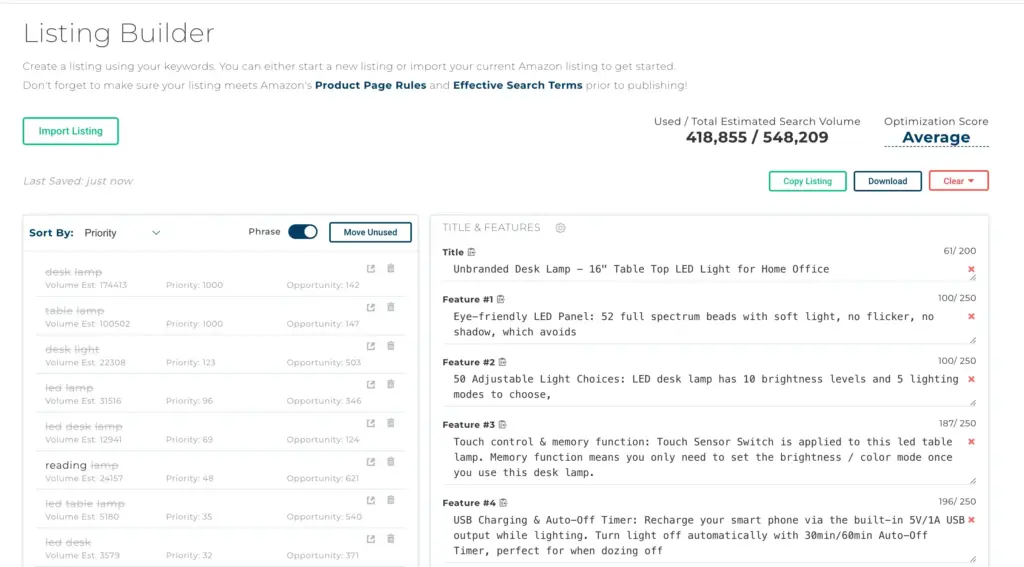Since allowing third-party sellers on its platform, Amazon’s vast marketplace has paved the way for entrepreneurs from all walks of life to succeed in e-commerce. Whether it’s a small business owner transitioning from a brick-and-mortar model, a retiree seeking to supplement their income, or a college student hustling to finance their education, the platform’s streamlined structure has opened doors for a diverse array of individuals to make entrepreneurship a viable option. Beneath the surface of these varied backgrounds lies a unifying thread: smart and strategic Amazon product research.
To use an old adage often attributed to Benjamin Franklin, “By failing to prepare, you are preparing to fail.” This rings true for Amazon sellers. Without proper product research, you’re setting yourself up for failure on Amazon, making it inevitable that you’ll run into unforeseen issues that can plague or doom your business before it begins. On the other hand, performing product research can pay off exponentially by finding the perfect product to take your online business to the next level.
In this article, we’ll sink our teeth into how to do product research for Amazon. After reading this, we hope you’ll be ready to dig into the nitty-gritty of the topic and start searching for profitable products to sell confidently.
What is Amazon Product Research?
Amazon product research is the process of analyzing data to find a product to sell on Amazon that meets specific criteria for profitability, demand, and market opportunity.
Generally, the goal is to find product opportunities with high customer demand, healthy sales potential, and relatively low competition.
Thorough research helps sellers pinpoint profitable niches and products amid Amazon’s seemingly endless selection.
Product research isn’t just about finding your first product, either. Successful Amazon sellers continually research to locate opportunities to expand their product lines. Consistently validating new product ideas through data is crucial for growing and maintaining a thriving Amazon business long-term.
Product Research Strategies for Different Types of Sellers

Every Amazon seller’s business model and goals are unique, so product research strategies must be customized accordingly. Whether selling private label products, pursuing dropshipping, sourcing via wholesale suppliers, or taking the retail arbitrage route, tailoring your research approach is essential.
Private Label Sellers
As a private label seller, your priorities are finding product opportunities with high potential demand, the ability to source profitably, and enough margin to market and brand the product effectively. At this stage of maturity in the Amazon marketplace, a focus on differentiation
Leveraging Amazon product research software like Viral Launch’s Product Discovery provides vital data on customer demand, historical sales trends, competition levels, and top sellers for any product you’re considering. With the most accurate data in the industry and adjustable filters, you can quickly identify promising niches that align with your vision, financial resources, and goals.
More than 60% of sales in the Amazon marketplace come from independent sellers, making private-label selling the most popular method of selling on Amazon. Our tools are generally designed with this type of seller in mind. While much of our tools’ data applies to anyone selling on Amazon, our tools are primarily created and maintained to account for private-label sellers’ specific needs and wants.
Dropship Sellers
Dropshipping on Amazon involves selling products without holding inventory, as orders are fulfilled directly from suppliers. For dropship sellers, success lies in finding reliable suppliers, selecting profitable products, and optimizing listings to stand out in a crowded marketplace.
When conducting product research, dropship sellers should focus on identifying products with high demand and low competition and assessing supplier reliability and product quality. Likely due to the appeal of making profits without making a product or dealing with inventory management, the dropshipping market on Amazon is extremely competitive because of saturation.
Wholesale Sellers
Wholesale sellers purchase products in bulk from manufacturers or distributors and resell them on Amazon. For wholesale sellers, product research involves identifying profitable products with high sales potential, negotiating favorable terms with suppliers, and effectively managing inventory to meet demand.
When conducting product research, wholesale sellers should analyze sales rankings, customer reviews, and competitor pricing to gauge market demand and competitiveness.
Retail Arbitrage Sellers
Retail arbitrage involves sourcing products from retail stores at discounted prices and reselling them for a profit. For retail arbitrage sellers, product research entails scouting for deals, assessing profit margins, and analyzing sales rank and demand to identify lucrative opportunities.
When conducting product research, retail arbitrage sellers should focus on sourcing products with consistent demand, high profit margins, and low competition.
Amazon Seller Tools for Product Research
The natural follow-up question for any of these sellers is, “How can I find products and product ideas that meet my needs?” The answer: Amazon seller product research tools. Since 2014, Viral Launch has offered sellers tools focused on helping sellers master how to find products to sell on Amazon.
Primarily, Viral Launch’s Product Discovery tool is considered the best Amazon product research tool available to sellers. It helps sellers save time by performing thorough product research with a seemingly endless amount of data for products and categories gathered from meticulously monitoring the Amazon marketplace for years.
Customizable filters related to category, monthly sales, monthly revenue, price, keyword search volume, and much more help tailor your search to exactly what you’re looking for, saving you countless hours searching for products that meet your goals and resources. Once you know what product hunting criteria are most relevant for you, Product Discovery goes to work by digging through its vast database to deliver the best products on the market that match your filters.
Additionally, validating the product idea with real insights and projections is just a click away. For instance, Viral Launch’s Market Intelligence tool helps take the next step in the product research process by giving you an overview of the current market, an AI-generated Product Idea Score based on general criteria for winning products, trends to be aware of, and a quick analysis on potential opportunities and threats that may arise if you decide to enter a particular market.
Together, Product Discovery and Market Intelligence work to give you everything you need to make smarter decisions and find winning products that cater to your wants, needs, and resources when starting an Amazon business or expanding your current product offering.
Step-By-Step Guide to Conducting Effective Product Research
Although product research can look different depending on your method of selling and budget, by and large, there are a few rules and guidelines that apply to everyone when performing effective product research. Below, we’ll dive into a few Amazon research techniques and strategies to consider when deciding how to find the right product to sell on Amazon.
1. Identify Product Opportunities
To find the best products to sell on Amazon, sellers can utilize various methods to uncover promising opportunities. From perusing the best selling products on Amazon to gain a better understanding of what’s hot with consumers to looking around your house or office for useful products you’ve purchased or add-ons that would make life easier for you, simply considering these items and identifying potential strengths and weaknesses related to selling them can get you started in the right direction.
Additionally, employing product research tools like the aforementioned combination of Viral Launch’s Product Discovery and Market Intelligence can streamline the process by offering customizable filters related to category, monthly sales, revenue, and more.
These tools efficiently sift through vast amounts of data, delivering potential products that align with sellers’ goals and resources, saving countless hours of manual searching.
2. Analyze Market Demand
If you remember anything from business classes, it’s likely the economic theory of supply and demand. Understanding market demand is crucial for selecting profitable products. It should be no surprise that market demand is a crucial factor in selling on Amazon. But how can you determine this before entering the seller marketplace?
Consider what you do when you are a customer in demand for a product. What do you do? Most likely, you go on Amazon and search for it! That’s where search volume estimates come into play, as they’re a strong indicator of demand and one of the more powerful Amazon customer demand insights available.
Sellers should delve into keyword research to gauge customer interest and search volume for potential products. By identifying relevant keywords and analyzing search trends, sellers can gain insights into customer behavior and preferences, helping them assess the viability of product ideas.
Is there enough customer demand volume to support your chances of competing? How much of the market demand gets swallowed up by the top sellers, who are unlikely to be toppled? Are you competing against big-box retailers or brands Amazon owns and manages that will be incredibly difficult to outrank and outsell? Answering these questions in your Amazon market analysis can validate your product idea and help you determine if this product is worth pursuing or if you’re destined to climb an uphill battle.
3. Evaluate the Competition

Analyzing the competition is essential for determining the feasibility of selling a particular product on Amazon. Sellers should examine competitor listings, reviews, and pricing strategies to understand market dynamics and identify areas for differentiation. Highlighting unique selling points and finding gaps in the market can give sellers a competitive edge and increase their chances of success.
Leveraging Amazon seller tools for competitive analysis, such as Viral Launch’s Competitor Intelligence, can provide valuable insights into competitor performance, allowing sellers to refine their strategies and stand out in the crowded marketplace. When performing an Amazon competitive analysis, think about how you can gain an edge with customers. How much room has been left for newcomers? Can you copy what they’re doing successfully and compete from a product value and pricing perspective? Contemplating these questions honestly and finding ways to gain an advantage, and gauging your likelihood of overcoming any disadvantages can go a long way in moving forward with a product.
4. Calculate Profitability
Before committing to a product, sellers must calculate its profitability to ensure it aligns with their financial goals. Factors such as sourcing costs, Amazon fees, shipping expenses, and taxes should be taken into account when estimating potential profits. Utilizing tools like Viral Launch’s FBA calculator simplifies the process by providing accurate profit margin calculations based on various cost inputs. And don’t forget about taxes! By carefully assessing profitability, sellers can make informed decisions and prioritize products with the highest potential for return on investment.
5. Legal and Compliance Issues to Be Aware Of
In your business’s short- and long-term best interests, staying within Amazon’s terms and conditions can pay off immensely, saving you money and headaches.
Ensuring your product complies with legal and Amazon regulations is certainly critical for a successful and sustainable Amazon business. Furthermore, here’s a breakdown of key considerations:
Intellectual Property Protection:
- Trademark & Patent Checks: Conduct thorough trademark and patent searches to avoid infringing on existing intellectual property. Tools like Amazon Brand Registry can help safeguard your brand.
- Copyright Considerations: Be mindful of copyrighted materials like designs, characters, or creative works. If you incorporate them into your product or packaging, ensure you have the necessary permissions. Amazon’s Patent Search tool can help you avoid issues related to IP.
Product Safety & Regulations:
- Restricted Product Categories: Amazon has strict guidelines on what can and cannot be sold. Familiarize yourself with prohibited and restricted product categories to avoid listing violations.
- Safety Standards: Certain product categories require compliance with specific safety regulations. Research and understand the relevant safety standards that may apply to your product, such as Consumer Product Safety Commission (CPSC) certifications for children’s toys or electronics safety standards.
Amazon’s Policies & Terms of Service:
- Stay Up-to-Date: Amazon’s policies and terms of service are subject to change. Stay updated to avoid listing suspensions or account issues. Resources like the News and Seller Forums tabes within Seller Central provide the latest guidelines directly from Amazon. Of course, our blog and r/FulfillmentByAmazon are great at keeping up with important updates affecting Amazon sellers.
By proactively addressing legal and compliance aspects, you’ll minimize risks and ensure a smooth selling experience on Amazon while protecting your business.
Optimize Product Listings for Better Visibility

Once you’ve identified a winning product, don’t underestimate the power of a well-optimized listing. You’ll increase your product’s visibility in Amazon’s search results by strategically incorporating relevant keywords throughout your product title, description, and high-quality images. This not only attracts more potential customers but also signals relevance to Amazon’s ranking algorithm.
- Know Your Audience: Before you write, step into your ideal customer’s shoes. What are their problems and desires? Tailor your language to resonate with their needs and buying habits.
- Keyword Magic: Conduct thorough keyword research. Use relevant keywords throughout your title, description, and bullet points, but prioritize readability over keyword stuffing. Remember, humans are the ones buying your product, not an algorithm.
- Speak Their Language: Use clear, concise language your target audience understands. Avoid jargon and technical terms that may cause confusion or stir doubt unless absolutely necessary. If you must include jargon or technical terms, keep it at a minimum to avoid losing the shopper.
- Utilize Your Space: To provide a uniform shopping experience, Amazon restricts the space and characters in listings. Because of this, we recommend leaving no stone unturned with this space. Max out on keywords and characters on the front-end and back-end and include as much information as possible to increase visibility and boost conversions.
- Test and Refine: Amazon allows A/B testing for product listings. Experiment with variations of your title, description, and bullet points to see what resonates best with your audience.
Following these keyword optimization tips will set your product up for success and drive organic traffic to your listing.
Final Thoughts
Effective product research is at the heart of any thriving Amazon business. By following these expert insights and leveraging the right tools, you can identify profitable products that meet your resources and goals and build a sturdy foundation for your online shop.
If you’re new to selling on Amazon, we understand that taking these steps toward online entrepreneurship can be difficult. But remember, every successful seller was once a beginner. From uncovering profitable product opportunities to optimizing your listings for maximum visibility, we’re here to support you every step of the way.
Finally, don’t let uncertainty hold you back! Take the next step on your journey to Amazon success today with Viral Launch. Sign up for a free trial and unlock the tools and resources needed to turn your e-commerce dreams into reality.








